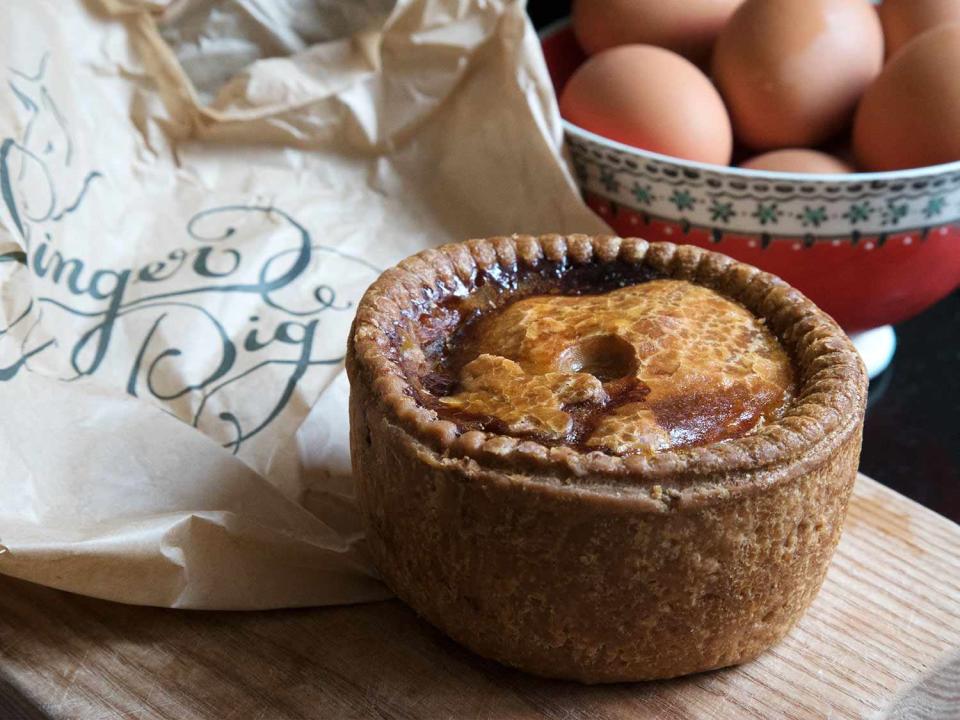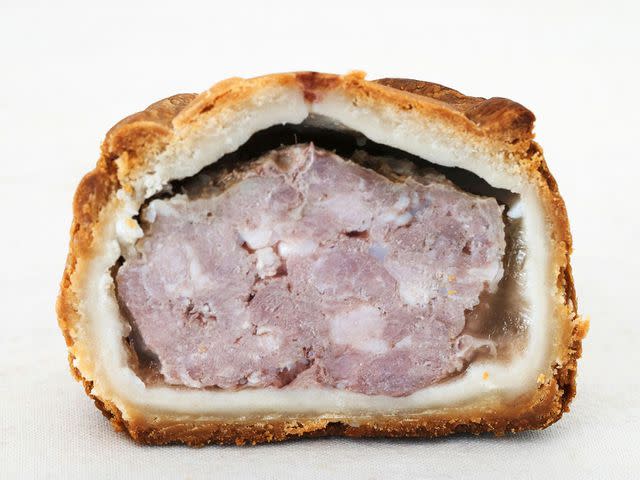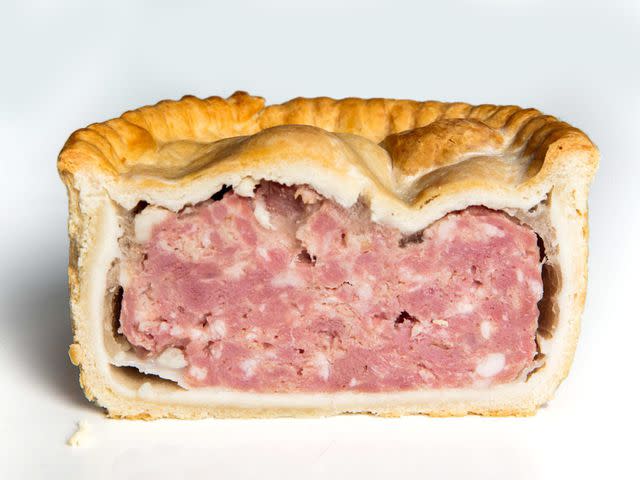How the Humble Pork Pie Charmed the English
The squat, round pork pie is arguably the most English pie of all.

Serious Eats
In British food culture, savory meat pies rank highly as both pocket-sized snacks and meals in their own right. There are steak and ale pies, pastry filled with beef braised in ale (not to be confused with steak and kidney pies, which are pastry filled with a mix of beef and chopped-up offal); there is, of course, the shepherd's pie, a crowd favorite both in the British Isles and abroad; there are pies filled with all manner of less common beasts and fish and fowl—eel pie, say, and squab pie—and there's fidget pie, which is more of a bacon tart than a true pie, filled with slices of cured meat, apple, and sometimes onions and potatoes. Meat pies figure heavily in British-inflected popular culture—think of Mrs. Lovett's meat pie shop in Sweeney Todd, and the old nursery rhyme "Sing a Song of Sixpence," which tells the story of "four and 20 blackbirds, baked in a pie."
But the squat, round pork pie is arguably the most English one of all. Typically produced and consumed in the eastern half of England, it is rarely spotted in Scotland, Wales, or even the West Country.
The ideal pork pie has a hot-water pastry shell that's been baked to a golden brown and comes topped with an equally burnished lid that's crimped around the edge. It should have a meaty filling made from coarsely ground pork, heavily seasoned with salt and pepper, plus the baker's secret (and often complex) combination of herbs and spices, all of it encased in a thin layer of wobbly jelly made from a rich stock. Sarah Pettegree, a pork pie connoisseur and owner of Norfolk-based Bray's Cottage Pork Pies, writes to me that most pie makers have closely guarded seasoning combinations for meat and jelly alike; the meat mixture can include anything from mace to anchovies, and the jelly can be boiled up with veggies, spices, or even citrus zest to add flavor. The closer you slide to the mass-produced end of the pork pie spectrum, the more finely ground and more poorly seasoned the meat filling will be.

The history of the pork pie is confusing and often contradictory. The first recorded proto–pork pie recipe appears in the medieval manuscript known as The Forme of Cury, attributed to the royal cooks of the court of Richard II and first published around 1390. A close look at the now-digitized recipe collection reveals that the recipe for "Mylates of Pork" is most pork pie–esque, as it contains ground pork ("hewe pork al to pecys") and is cooked in a rudimentary pastry shell. But there are crucial differences, such as the addition of both cheese and eggs to the seasoned pork mixture, as well as the recipe's explicit calls for saffron. While it is perhaps more of a borderline quiche than a pork pie, the bones of the modern dish are there.
Pettegree suggests a different 14th-century recipe as a candidate for the original pork pie: the appropriately named "Pig Pye," printed in Dorothy Hartley's 1954 Food in England. The recipe calls for pork, plus mace and other seasonings; the dish could be enjoyed hot or cold, but the addition of currants set it apart from our present-day savory versions. However, Laura Mason, a food historian and author of several books on British food, remains skeptical about the reliability of this recipe, noting that Hartley's research-gathering methods have recently come under scrutiny.

What we do know is that early pork pies were dished up in what were rather ominously known as "coffins," or "cofyns." Janet Clarkson, in her excellent book Pie: A Global History, writes that the original pork pie crusts were "tall, straight-sided with sealed-on floors and lids," not unlike today's gala pies (large, rectangular pork pies, with a signature, somewhat disturbing core of elongated boiled egg). According to Clarkson, modern texts often describe the outer pastry shell as an element that was regularly discarded, in part because the long cooking times of early pork pies would render the crusts tough and inedible by modern standards—a conclusion that, she is quick to note, makes little sense. Regula Ysewijn, in her book Pride and Pudding, also dismisses "the notion...that pastry was never eaten in [the 14th century]" as "nonsense," and Dr. Annie Gray, a food historian and author of The Greedy Queen: Eating With Victoria, confirms that "the crust was eaten, it's illogical that anything edible would be thrown away."

It wasn't until the 18th century that pork pies more similar to contemporary versions started coming into fashion, and they were especially popular in and around the English East Midlands town of Melton Mowbray, Leicestershire. Why Melton Mowbray? In a word: cheese. The region's burgeoning dairy industry produced an abundance of whey, a protein-rich and, above all, free source of sustenance for livestock, including pigs. As Dr. Gray says, pigs were animals "associated with poverty" that "anyone could and did keep," thanks to their handy proclivity to dine on scraps. This, Mason observes, made pork a key part of the rural economy in particular. A proto–pork pie was a handy way of preserving meat and prolonging its shelf life, through the use of salt and limiting its exposure to oxygen, long after the pigs were slaughtered.
It was also a conveniently portable snack. Reportedly, farmhands in the Melton Mowbray region would tuck into these rudimentary pies from time to time; when the upper echelons of English society descended on the area to take part in their pastime of choice, foxhunting, they spotted the farmhands-turned-grooms eating their rough pastry-wrapped pork and wanted a literal slice of the action. In this way, pies gradually became associated with "picnics, high teas and shooting teas [food served to the participants in a hunt]," says Gray. We can safely assume that these early pork pies were a bit plainer than our well-seasoned modern-day iterations: A turn-of-the-19th-century recipe from Maria Eliza Rundell's A New System of Domestic Cookery describes them as using a "very plain crust," stuffed with meat seasoned only with salt and pepper.

Around the same period, pork pies were considered "a good solid treat dish for the middle and upper working classes," adds Gray. After all, making pies at home was time-consuming and required an oven, an appliance many working-class people didn't have. It makes sense that they were often saved for a once-a-year event like Christmas (which also happens to fall around slaughter season). This consumption pattern endures today, and for many pork pie producers, Christmas remains peak pie-selling time. In the Midlands, pork pies form an integral part of Christmastime traditions for many families, served up for breakfast alongside a pickled onion or a glass of Buck's Fizz, a mimosa-like concoction of sparkling wine and orange juice. It was said that even author D. H. Lawrence got in on the festive act.
This early Christmastime tradition of pork pie eating may have eventually allowed the dish to shift from a preservative method to a food enjoyed for its distinct culinary virtues. But the advent of industrially milled and thus more affordable white wheat flour certainly played a role as well. As Mason notes, cheaper flour allowed pork pies more akin to our refined, modern versions to become widely available, which paved the way for the dish to cement its place in English cuisine.

Serious Eats / Vicky Wasik
Interior of a Yorkshire pie.Melton Mowbray versions, with their bowed, hand-raised sides, well-seasoned aspic, and gray pork center (thanks to the use of raw, uncured meat), are so iconic that they've achieved protected geographical status, putting them up there with Champagne and Parma ham. But whether they're the country's best pork pies is debatable—northern England also has its fingers in many pies. Yorkshire variations are slightly smaller and molded, but still bear that traditional crimped lid; made from cured instead of raw pork, their meaty core is rather more disconcertingly pink and lends the pie a "hammier" flavor. This type of pie is also known as a "growler," a name that popular local myths trace back to two possible sources: the rumble of a pre-pie tummy, and the less savory stomach noise made post-pie.

Regional rivalries aside, the English have opinions on every aspect of pork pies, from temperature to toppings. Are they best served at room temperature with brown sauce (the tangy yin to ketchup's sweeter yang, not dissimilar to A1 sauce) for a ploughman's lunch or a picnic in the park? Or should they be enjoyed warm, perhaps with an unnaturally green dollop of mushy peas? Preferences are defined as much by generational tastes as regional ones; Pettegree notes that "older people, especially from Yorkshire and Lincolnshire" regularly mention queueing to get pork pies fresh from the oven, adding (rightly, if you ask me) that "a hot pork pie is indeed a rare joy." And the jelly, too, remains divisive, as gelatinous substances tend to be. Some pork pie eaters pick it out before devouring the meat and pastry, while others relish the wobbly addition. The one thing pork pie aficionados can agree on? Mass-produced pork pies are a travesty.

Over the centuries of its existence, the pork pie's evolution has been a winding path, from the homely stuff of peasants to the snack-on-the-go of the British elite to a democratic comfort food for all. Nowadays, pork pies are no longer relegated to buffet-style teas and picnics (although they're still mainstays of both) and instead take center stage at all manner of celebrations. Along with that shift has come a new form and a new stage of life: the custom pork pie. From lettering-topped birthday pies to desirable stylized stacks for couples who want to seal their union with a pork pie wedding cake, "bespoke, commissioned pork pie has definitely become a thing," confirms Pettegree. Once again, the humble pork pie has ascended from practical to fashionable.

